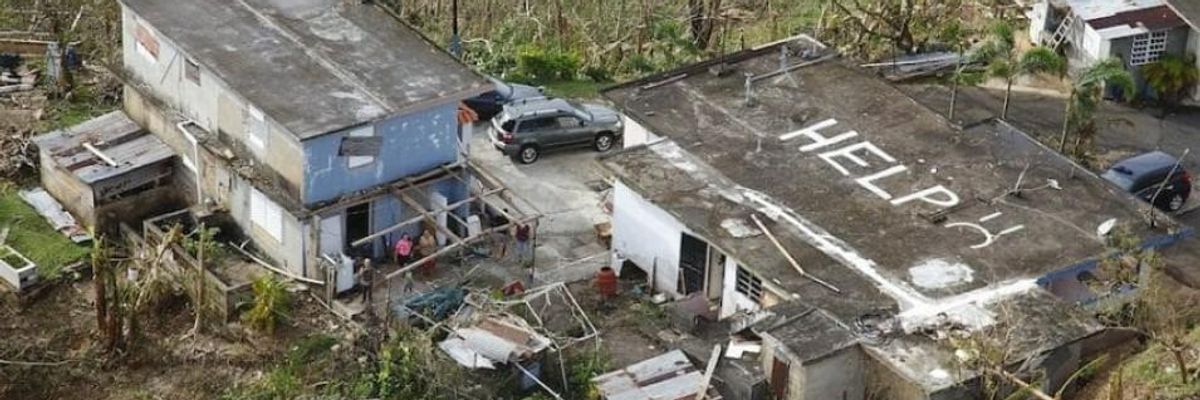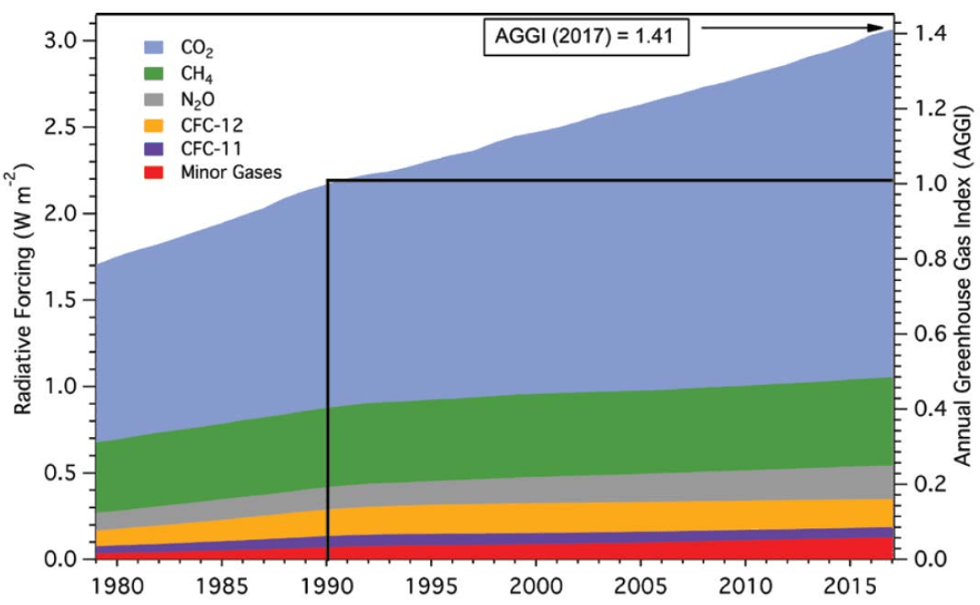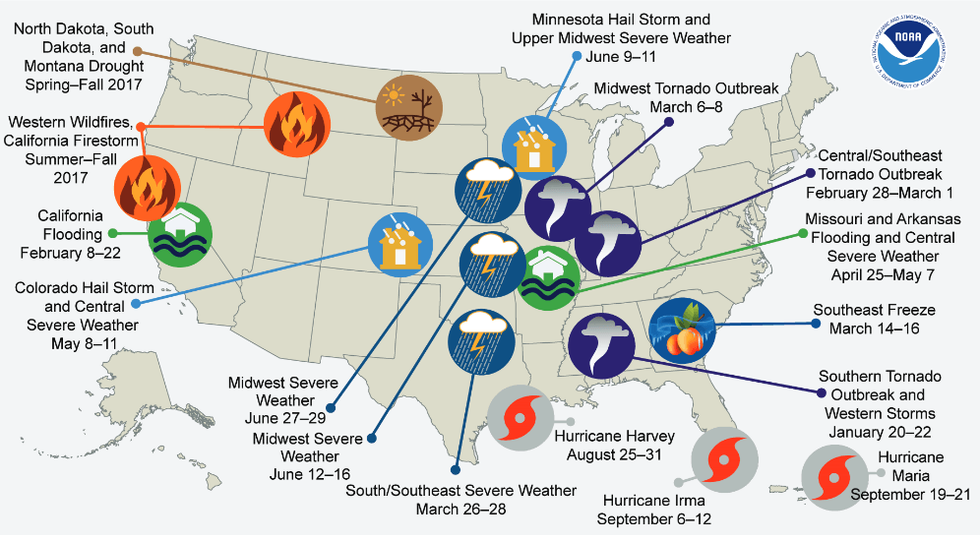

SUBSCRIBE TO OUR FREE NEWSLETTER
Daily news & progressive opinion—funded by the people, not the corporations—delivered straight to your inbox.
5
#000000
#FFFFFF
To donate by check, phone, or other method, see our More Ways to Give page.


Daily news & progressive opinion—funded by the people, not the corporations—delivered straight to your inbox.

While conducting search and rescue in the mountains of Puerto Rico following Hurricane Maria in September of 2017, a U.S. Customs and Border Protection (CBP) Air and Marine Operations Black Hawk located a home with HELP painted on its roof. (Photo: U.S. CBP/Wikimedia)
As temperatures bust heat records across the globe and wildfires rage from California to the Arctic, a new report produced annually by more than 500 scientists worldwide found that last year, the carbon dioxide concentrations in the Earth's atmosphere reached the highest levels "in the modern atmospheric measurement record and in ice core records dating back as far as 800,000 years."
While the most significant jump was the global average for carbon dioxide (CO2)--which, at 405.0 parts per million (ppm), saw a 2.2 ppm increase from the previous year--concentrations of other dominant planet-warming greenhouse gases, methane (CH4) and nitrous oxide (N2O), also hit "record highs," according to State of the Climate in 2017 (pdf) released Wednesday.

Considering those rates, Greg Johnson, an oceanographer at the National Oceanic and Atmospheric Administration (NOAA) Pacific Marine Environmental Laboratory in Seattle, warned that even if humanity "stopped the greenhouse gases at their current concentrations today, the atmosphere would still continue to warm for next couple decades to maybe a century."
The 332-page report--which was overseen by NOAA and published as a special supplement to the Bulletin of the American Meteorological Society--also notes that 2017 is among the three hottest years ever, taking the top spot for warmest non-El Nino year since scientists began measuring in the 1800s. However, NOAA data released last weekend shows that 2018 is on track to set a new record.
The report details how "much-warmer-than-average conditions" across much of the world's lands and oceans has meant three years of "unprecedented" coral bleaching, Arctic air temperatures that are "warming at a pace that was twice the rate of the rest of the world," rapidly melting glaciers and ice sheets, and devastating tropical storms--such as Hurricanes Irma and Maria--that reflect "the very active state of the Atlantic basin."
In its regional analyses, the report notes that "the United States was impacted by 16 weather and climate events that each caused over $1 billion (U.S. dollars) in damages. Since records began in 1980, 2017 is tied with 2011 for the greatest number of billion-dollar disasters. Included in this total are the western U.S. wildfire season and Hurricanes Harvey, Maria, and Irma. Tornado activity in the United States in 2017 was above average for the first time since 2011, with 1,400 confirmed tornadoes."

It also features a map that highlights notable climate anomalies and events across the globe during 2017. The graphic points out that both Argentina and Uruguay experienced their warmest years on record while Russia experienced its second wettest, and five of six observatories in Alaska documented record high permafrost temperatures.
Permafrost is a layer of soil, rock, or sediment that remains frozen and contains massive amounts of carbon dioxide and methane. Climate scientists are growing increasingly concerned that "as the global thermostat rises, permafrost, rather than storing carbon, could become a significant source of planet-heating emissions."


Dear Common Dreams reader, The U.S. is on a fast track to authoritarianism like nothing I've ever seen. Meanwhile, corporate news outlets are utterly capitulating to Trump, twisting their coverage to avoid drawing his ire while lining up to stuff cash in his pockets. That's why I believe that Common Dreams is doing the best and most consequential reporting that we've ever done. Our small but mighty team is a progressive reporting powerhouse, covering the news every day that the corporate media never will. Our mission has always been simple: To inform. To inspire. And to ignite change for the common good. Now here's the key piece that I want all our readers to understand: None of this would be possible without your financial support. That's not just some fundraising cliche. It's the absolute and literal truth. We don't accept corporate advertising and never will. We don't have a paywall because we don't think people should be blocked from critical news based on their ability to pay. Everything we do is funded by the donations of readers like you. Will you donate now to help power the nonprofit, independent reporting of Common Dreams? Thank you for being a vital member of our community. Together, we can keep independent journalism alive when it’s needed most. - Craig Brown, Co-founder |
As temperatures bust heat records across the globe and wildfires rage from California to the Arctic, a new report produced annually by more than 500 scientists worldwide found that last year, the carbon dioxide concentrations in the Earth's atmosphere reached the highest levels "in the modern atmospheric measurement record and in ice core records dating back as far as 800,000 years."
While the most significant jump was the global average for carbon dioxide (CO2)--which, at 405.0 parts per million (ppm), saw a 2.2 ppm increase from the previous year--concentrations of other dominant planet-warming greenhouse gases, methane (CH4) and nitrous oxide (N2O), also hit "record highs," according to State of the Climate in 2017 (pdf) released Wednesday.

Considering those rates, Greg Johnson, an oceanographer at the National Oceanic and Atmospheric Administration (NOAA) Pacific Marine Environmental Laboratory in Seattle, warned that even if humanity "stopped the greenhouse gases at their current concentrations today, the atmosphere would still continue to warm for next couple decades to maybe a century."
The 332-page report--which was overseen by NOAA and published as a special supplement to the Bulletin of the American Meteorological Society--also notes that 2017 is among the three hottest years ever, taking the top spot for warmest non-El Nino year since scientists began measuring in the 1800s. However, NOAA data released last weekend shows that 2018 is on track to set a new record.
The report details how "much-warmer-than-average conditions" across much of the world's lands and oceans has meant three years of "unprecedented" coral bleaching, Arctic air temperatures that are "warming at a pace that was twice the rate of the rest of the world," rapidly melting glaciers and ice sheets, and devastating tropical storms--such as Hurricanes Irma and Maria--that reflect "the very active state of the Atlantic basin."
In its regional analyses, the report notes that "the United States was impacted by 16 weather and climate events that each caused over $1 billion (U.S. dollars) in damages. Since records began in 1980, 2017 is tied with 2011 for the greatest number of billion-dollar disasters. Included in this total are the western U.S. wildfire season and Hurricanes Harvey, Maria, and Irma. Tornado activity in the United States in 2017 was above average for the first time since 2011, with 1,400 confirmed tornadoes."

It also features a map that highlights notable climate anomalies and events across the globe during 2017. The graphic points out that both Argentina and Uruguay experienced their warmest years on record while Russia experienced its second wettest, and five of six observatories in Alaska documented record high permafrost temperatures.
Permafrost is a layer of soil, rock, or sediment that remains frozen and contains massive amounts of carbon dioxide and methane. Climate scientists are growing increasingly concerned that "as the global thermostat rises, permafrost, rather than storing carbon, could become a significant source of planet-heating emissions."


As temperatures bust heat records across the globe and wildfires rage from California to the Arctic, a new report produced annually by more than 500 scientists worldwide found that last year, the carbon dioxide concentrations in the Earth's atmosphere reached the highest levels "in the modern atmospheric measurement record and in ice core records dating back as far as 800,000 years."
While the most significant jump was the global average for carbon dioxide (CO2)--which, at 405.0 parts per million (ppm), saw a 2.2 ppm increase from the previous year--concentrations of other dominant planet-warming greenhouse gases, methane (CH4) and nitrous oxide (N2O), also hit "record highs," according to State of the Climate in 2017 (pdf) released Wednesday.

Considering those rates, Greg Johnson, an oceanographer at the National Oceanic and Atmospheric Administration (NOAA) Pacific Marine Environmental Laboratory in Seattle, warned that even if humanity "stopped the greenhouse gases at their current concentrations today, the atmosphere would still continue to warm for next couple decades to maybe a century."
The 332-page report--which was overseen by NOAA and published as a special supplement to the Bulletin of the American Meteorological Society--also notes that 2017 is among the three hottest years ever, taking the top spot for warmest non-El Nino year since scientists began measuring in the 1800s. However, NOAA data released last weekend shows that 2018 is on track to set a new record.
The report details how "much-warmer-than-average conditions" across much of the world's lands and oceans has meant three years of "unprecedented" coral bleaching, Arctic air temperatures that are "warming at a pace that was twice the rate of the rest of the world," rapidly melting glaciers and ice sheets, and devastating tropical storms--such as Hurricanes Irma and Maria--that reflect "the very active state of the Atlantic basin."
In its regional analyses, the report notes that "the United States was impacted by 16 weather and climate events that each caused over $1 billion (U.S. dollars) in damages. Since records began in 1980, 2017 is tied with 2011 for the greatest number of billion-dollar disasters. Included in this total are the western U.S. wildfire season and Hurricanes Harvey, Maria, and Irma. Tornado activity in the United States in 2017 was above average for the first time since 2011, with 1,400 confirmed tornadoes."

It also features a map that highlights notable climate anomalies and events across the globe during 2017. The graphic points out that both Argentina and Uruguay experienced their warmest years on record while Russia experienced its second wettest, and five of six observatories in Alaska documented record high permafrost temperatures.
Permafrost is a layer of soil, rock, or sediment that remains frozen and contains massive amounts of carbon dioxide and methane. Climate scientists are growing increasingly concerned that "as the global thermostat rises, permafrost, rather than storing carbon, could become a significant source of planet-heating emissions."

